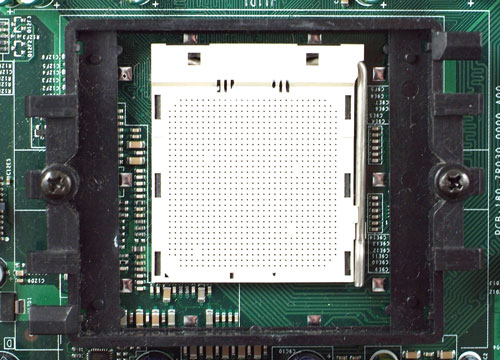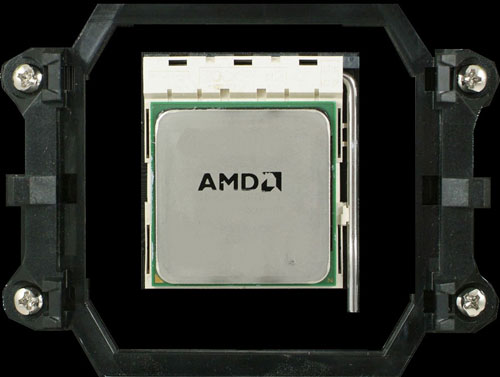AMD AM2: More than just a Memory Change
by Wesley Fink on February 6, 2006 1:30 AM EST- Posted in
- CPUs
New AM2 Cage
With the two 940 sockets so similar you would reasonably expect existing heatsink/fans to work on the new AM2.
It appears AM2 will change this ongoing HSF compatibility with a brand new, and mostly incompatible, heatsink cage design. The new AM2 design, if it makes it to final production, is a nice upgrade to the existing Athlon 64 HSF mounting design, but there are almost no current Athlon 64 HSFs that will fit the new design.
If you look at the designs side-by-side you can see the differences more clearly.
Socket 939/940/754 HSF Cage

AM2 HSF Cage
In addition the current high-end designs, which replace the existing cage with a new mounting system just simply won't work. The current Athlon 64 design uses one screw on each side in the center of the mounting lug. The new AM2 design uses four corner mounted screws - more secure but not useful for mounting current 2 screw mounting schemes.
Current Athlon 64 heatsinks that use a single lug for mounting and no cam for locking will likely work on the new AM2 cage. Recently shipped AMD retail heatsinks have a single lug connection and a lever lock without the locking cam. Those should work fine on the new AM2. However, not a single third party HSF in our lab - the kinds our readers most likley use - would mount properly on the new AM2 cage.










50 Comments
View All Comments
eddiedu - Tuesday, February 7, 2006 - link
I´m not shure! Anyone has idea when it´s going to be released?Every news that a read says that the release date is going to later, the first time was supposed to release q2 and now july.
What do you think?
Thanks
mesyn191 - Tuesday, February 7, 2006 - link
All rumours...Wait for offical announcement from AMD.
Alexvrb - Tuesday, February 7, 2006 - link
I for one did not expect to see quite so many complaining about upgrade issues. AM2 is an evolutionary step - there's nothing forcing you to ditch your current systems. If you want them to stick with an aging platform for another few years so you have a "better" upgrade path, that's great. But the sooner they get AM2 out, the sooner people with slow systems have a new, better option. The change has to happen eventually, and no matter when it does, the complaints will be the same. When your rig is no longer sufficient, and you have to upgrade, AM2 will be there for you. In the meantime, Socket 939 is great, and if you have a single core chip, you can still drop in a dual core any time you feel you need the extra performance.The heatsink issue is understandable annoying, but that's a bit overblown too. If you have enough money to immediately dump your motherboard, CPU, and RAM and build a new AM2 setup, I don't think a heatsink is a problem. If you're that dedicated (and somehow still cheap), you can probably modify existing heatsinks to work. For other heatsinks, new adapters should pop up. For watercooling if your block absolutely can't be made to work, you will no doubt soon be able to get a new one. It's worth spending 40 or 50 bucks to be able to reuse your $200+ watercooling system, so you can dump one fast overclocked system for a slightly faster one. ;)
The biggest issue I have with AMD lately has nothing to do with platform. It's the lack of OEM chips available to advanced end users. When you can get them, the cost difference isn't significant. But I do understand (part of) why they do it. It's less trouble for retailers to sell boxed chips with a guaranteed-to-work heatsink and a better warranty.
dev0lution - Tuesday, February 7, 2006 - link
The lack of OEM chips is to prevent OEM's from dumping product they got at a discount for cheaper because it was supposed to go in a complete system. OEM chips that THEY were supposed to warranty end up with end-users who tend to get a bit annoyed when that OEM chip needs to be RMA'd and AMD won't take it back.And for those who're counting, Intel's jumped from 478 to 775 and to add to it, they threw in a chipset change that wasn't backwards compatible when dual core dropped. So you potentially could have had to upgrade your chip, board and memory then have to do a chip plus board upgrade to move from 478 to Intel dual core, all in the same timeframe you could have gone from the initial 939 release to an X2 today.
And I agree, if you're going to spend the $ for a new chip, mobo and DDR2, what's another few bucks for a new bracket for your HSF?
SynthDude2001 - Monday, February 6, 2006 - link
After buying a relatively low priced dual-core Opteron a few months ago, I could not be any less interested in AM2 right now. So, we'd need a new CPU, new motherboard, new RAM, new heatsink...for what performance gains exactly? Until 65nm chips come out, IMO this new platform won't be worth the money for most people - particularly those already on Socket 939 setups. Is DDR1 memory really holding AMD back that much?.....NullSubroutine - Tuesday, February 7, 2006 - link
It is not so much abotu DDR1 holding back AMD's product, but so much that DDR2 will be the new standard, just as PC133 was eventually phased out. Albeit, DDR1 to DDR2 should not be so much as a jump as PC133 to DDR1, but it largely more ficically efficient to do so. Intel has been using (slower) DDR2 for some time now, and now that DDR2 have reached speeds where there is no penalty for using it, or perhaps a small to medium increase of performance, AMD wishes to adopt DDR2 so it can help streamline the industry. When both CPU manufacturers use the same type of memory, the memory manufactures can produce cheaper products.AMD is natorious *spelling* for making it easy for manufacturers in the industry and this helps with adoption of their product. This is besides the point that DDR2 has lower power requirements than DDR1, which is very important for the mobile sector, it is not feasible for AMD to only adopt DDR2 for its mobile sector and negate its desktop and server platforms, nor is it realistic considering AMD's model of creating products is a Server down platform. All products derivitive of the original "beefiest" chip. This is why the entire platform is getting a change to DDR2, and it is an inevitable change.
This is not to replace 939 instantiously. AMD wants to bring a whole bunch of new features, and ever so often a platform upgrade is appropriate because some of the new features may require a new chipset or pin array. Think of this as a gradual phase out, over a several year period, rather than instant your 939 system sucks.
mesyn191 - Monday, February 6, 2006 - link
If you just bought a dual Opteron system a few months ago there is no need for you to upgrade anything at all, AM2 is for single socket consumer grade systems anyways, why would you even look at it if you're already needing something from the dual socket market?Anyways... they can't scale DDR1 anymore and its getting more expensive as DDR2 ramps up in production. DDR2 still has a way to scale before its EOL'd so we should see some significant performance gains before it goes the way of the dodo and DRR3 comes out.
This new socket, even on 90nm, is worth upgrading for those who are currently still on socket 754 or, if you're like me, have one of the first socket 939 motherboards/CPU's that were on the market as socket AM2 should bring some of the first really cheap (well , relatively cheap...) dual core consumer grade chips from AMD.
drag - Monday, February 6, 2006 - link
I'll take whatever they give me as far as heatsinks are concerned.Personally I am looking forward to the Pacifica virtualization 'enhancements' to make it easier to play around with software. Currently I use Xen, but the only systems that support it on the current generation x86 systems are Linux and FreeBSD (which is fine). But with Pacifica or Intel's VTs then I can use whatever I want to use. Windows, OS X, ReactOS, OpenBSD, FreeBSD, Dragonfly, etc etc etc.
I don't care about cpu speed or memory speed. I just want the ability to use lots of cheap RAM and multicore/smp would be a plus.
drfred - Monday, February 6, 2006 - link
Aren't those BTX heatsink mounting holes on the AM2 bracket? They look strikingly familiar.Avalon - Monday, February 6, 2006 - link
Not as much info as I had hoped for. I was a bit disappointed when I read that most current A64 heatsinks will not be compatible with AM2 and the new socket, but then a previous user pointed out that Thermalright and the like are usually pretty quick to make socket adapters for new socket changes. Spending $5 for an AM2 s940 adapter for my SI-120 is much better than me having to use whatever stock HSF comes with new AM2 processors or buying a whole new HSF.Other than that...I'm mostly interested in seeing what effect DDR2 memory has on AMD's lineup. It might almost be worth an upgrade if it was something around the 10%-15% range, although that's probably wishful thinking.